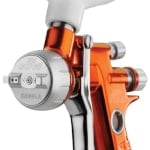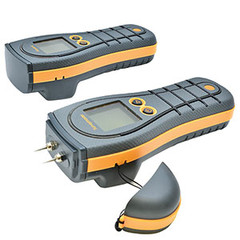Gauges to evaluate moisture content on a variety of substrates.
Types of Moisture Meters
On porous material such as concrete, plaster, brick, wood, the moisture content of the substrate should be measured, as the presence of moisture within a material will result in poor adhesion, premature coating failure and poor appearance.
It is not sufficient to simply ensure that the surface is dry as often the surface of the substrate is the dries point - due to evaporation. It is important to establish the moisture content within the substrate itself.
When powder coating wooden panels, for example if the wood (or mdf) has too high a moisture content as the panel passes through the oven, the moisture heated, generating steam - causing significant coating finish issues.
Applying a coating to concrete floor which is too damp can cause premature adhesion failure. Moisture meters have been developed to specifically determine the level of moisture in a substrate and come in two forms:
Pin-type moisture meters: Invasive pins are pushed firmly into the surface of the substrate being measured and by measuring the electrical resistance between the pin electrodes provide the percentage moisture content (%MC) in the substrate.
Pinless, contact-type moisture meters: Whilst pinless meters typically measure moisture content faster and are non-destructive they do require a relatively flat surface because the sensors are mounted on the base of the gauge making them ideal for concrete.
















